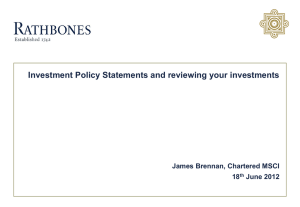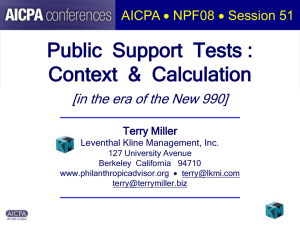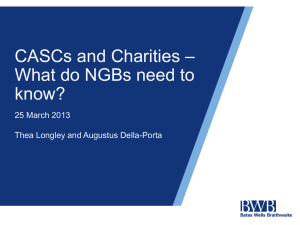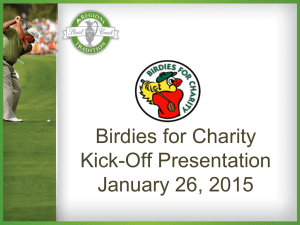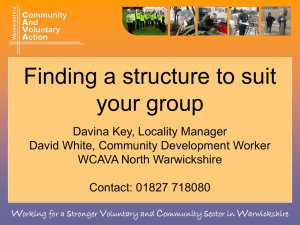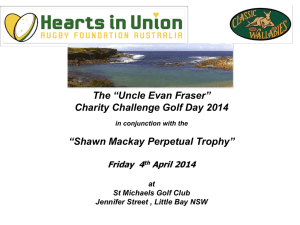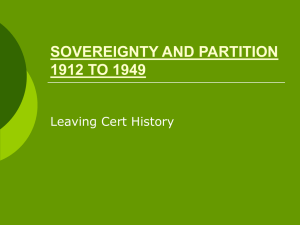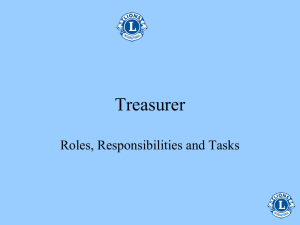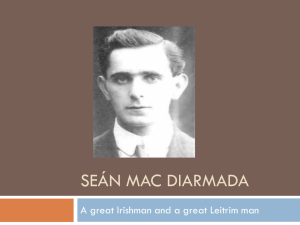Joe Saxton`s Presentation
advertisement
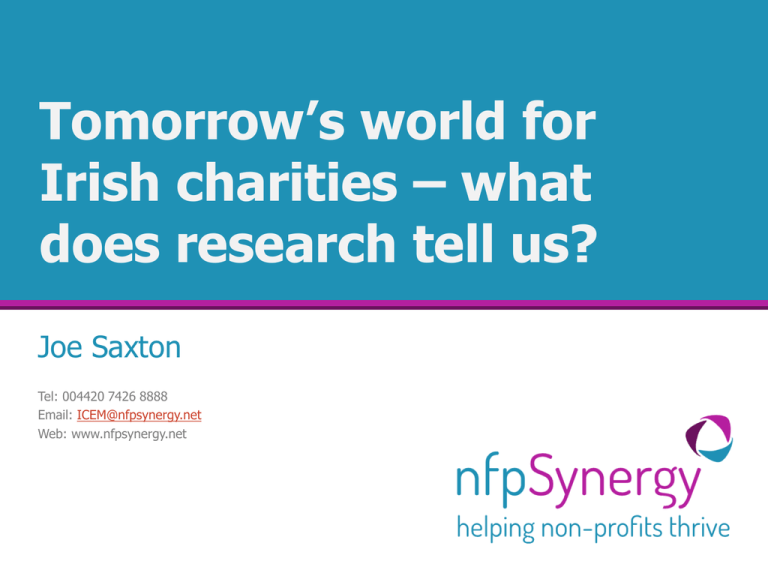
Tomorrow’s world for Irish charities – what does research tell us? Joe Saxton Tel: 004420 7426 8888 Email: ICEM@nfpsynergy.net Web: www.nfpsynergy.net Five big issues • • • • • Economics, politics and recession Ways of giving are changing Donors want to be re-assured Is trust the house built on sand Charities can be their own worst enemy Five big issues • • • • • Economics, politics and recession Ways of giving are changing Donors want to be re-assured Is trust the house built on sand Charities can be their own worst enemy Key issues… • Domestic economy is still very weak: The near term GDP growth is expected to be driven entirely by net trade, reflecting subdued imports rather than strong exports. Consumer spending and investment are expected to fall though most of 2013 • A fragile labour market: unemployment beginning to stabalise at 14.1% but pre-crisis norm was 4.5% • Damp consumer spending: expected fall by 1.6% in 2013 followed by no growth in 2014 • The depressed housing market: prices fell for the fourth consecutive month in March, taking the price level to more than 50% below pre-crisis peaks. one in eight mortgages are in arrears and a new state insolvency service has been set up to try to broker deals between debtors and lenders. This increases the risk of repossessions rising • Tight credit conditions: will restricting business investment – by 3.4% this year, before starting to rise in 2014 Source: Oxford Economics/nVision, nfpSynergy 2013 The gap between worshippers and nonworshippers has stabilised recently 100% 88% 83% 80% 74% 70% 60% Regular worshipper 40% Non- worshipper 20% Apr/May-13 Nov-12 May-12 Nov-11 May-11 Nov-10 Mar-10 Nov-09 Aug-09 Mar-09 Nov-08 Mar-08 0% “Within the past three months, have you given any money to charities?” Those who answered ‘Yes’ Base: All respondents (1,408), 16+, Republic of Ireland Source: Irish Charity Engagement Monitor, Apr/May 2013, nfpSynergy 5 The public remain highly pessimistic about giving 30% Last 12 months Next 12 months 20% 10% 7% 7% 0% Nov-08 Aug-09 Mar-10 Nov-10 May-11 -6% -10% -10% -20% -21% -8% -21% Nov-11 -6% Apr-12 -7% Nov-12 Apr/May-13 -7% -8% -19% -23% -27% -30% -29% “Looking back over the last year or so, how has the amount that you gave to charity changed with respect to previous years?” “Looking forward to the year ahead, how do you expect the amount of money that you give to charity to change? “ Base: All respondents (1,408), 16+, Republic of Ireland Source: Irish Charity Engagement Monitor, Apr/May 2013, nfpSynergy 7 A quarter of respondents had volunteered their time in the last three months 26% Yes No 74% Have you given time as a volunteer to an organisation in the last 3 months? Base: All respondents (1,408), 16+, Republic of Ireland Source: Irish Charity Engagement Monitor, Apr/May 2013, nfpSynergy 8 The last two years have seen a shift towards localism 46% 41% A charity working in my local area 34% 24% A charity working wherever there is the greatest need 33% 37% 21% A charity working in the whole of Ireland Apr/May-13 18% 22% Apr-12 Apr/May-11 3% A charity working overseas 3% 3% “If you had € 10 to donate to charity, which of the following would you be most likely to give it to?” Base: All respondents (1,408), 16+, Republic of Ireland Source: Irish Charity Engagement Monitor, Apr/May 2013, nfpSynergy Localism is strongest in Munster 100% A charity working in my local area - Apr-12 A charity working in my local area - Apr/May-13 80% 60% 55% 48% 46% 40% 43% 41% 38% 41% 51% 44% 31% 20% 0% Total Dublin Rest of Leinster Munster Connacht/ Ulster “Looking forward to the year ahead, how do you expect the amount of money that you give to charity to change?” Base: All respondents (1,408), 16+, Republic of Ireland Source: Irish Charity Engagement Monitor, Apr/May 2013, nfpSynergy Commercial manifestations “Given the choice, our customers tell us they prefer to buy Irish, as they like the guaranteed quality that comes with buying Irish and want to support the local economy. We wanted to emphasise to our customers that our grocery offering features authentic Irish products, supplied by local Irish farmers and producers” Charity activity 12 Five big issues • • • • • Economics, politics and recession Ways of giving are changing Donors want to be re-assured Is trust the house built on sand Charities can be their own worst enemy Visibility of face to face operations increases 69% Face-to-face on the street 60% 63% 66% Via a cash collection on the street Through a television advert with a telephone number to call to donate 50% 57% 38% 42% Via an appeal mailing/ letter 38% 34% On your doorstep 37% 42% Adverts/leaflets in newspapers/magazines 34% 40% Through the radio 25% 24% Online advertising 17% 16% Via email 13% 14% On the telephone Via text message through mobile phone Apr/May-13 May-11 7% 5% “In the last three months, have you been asked for money by a charity in any of the following ways? Please select all that apply.” Base: Those who have been asked for money by a charity in the past 3 months (919) among 1,408 adults, 16+, Republic of Ireland 14 Source: Irish Charity Engagement Monitor, Apr/May 2013, nfpSynergy Recessionary trends continue to dominate 100% Donating clothing/products to a charity shop, 77% On-street cash collections, 77% 80% Sponsoring someone to take part in an event, 65% Buying clothing/products in charity shops, 56% 60% 40% Taking part in an event, 33% By standing order or direct debit, 23% 20% 0% Apr-09 Jul-09 Nov-09 Nov-10 Apr/ May-11 Nov-11 Apr-12 Nov-12 Apr/May13 “Through which methods did you give?” Base: Those who have given to charity in the past 3 months (1,032) among 1,408 adults, 16+, Republic of Ireland Source: Irish Charity Engagement Monitor, Apr/May 2013, nfpSynergy 15 Emerging ways of giving… 21% Online Buying an alternative Charity Gift - eg 'Give a Goat' 18% 17% By text message By sending in a cheque/cash/postal order 16% 13% At a charity auction 12% By post Buying or selling products through e-bay 9% By phone 9% Payroll giving 7% At a bank/building society/ATM machine 7% Apr/May-13 Apr-12 “Through which methods did you give?” Base: Those who have given to charity in the past 3 months (1,032) among 1,408 adults, 16+, Republic of Ireland Source: Irish Charity Engagement Monitor, Apr/May 2013, nfpSynergy 16 In Britain, there is a smaller gap between cash and direct debit giving 70% Envelope/tin Direct debit 60% 50% 39% 40% 37% 30% 34% 26% 20% 10% Nov-12 Jul-12 Mar-12 Nov-11 Jul-11 Mar-11 Nov-10 Jul-10 Mar-10 Nov-09 Jul-09 Mar-09 Nov-08 Jul-08 Mar-08 Nov-07 Jul-07 Mar-07 Nov-06 Jul-06 Mar-06 Nov-05 Jul-05 Mar-05 Nov-04 Jul-04 Mar-04 Nov-03 Jul-03 Mar-03 0% “If yes, have you given to a collection tin/envelope through the door or by standing order/direct debit or via a membership subscription?” Base: 1,000 adults 16+, Britain. Source: Charity Awareness Monitor, Jan 13, nfpSynergy 17 Unintrusive methods of contact are still most popular among donors Through a television advert with a telephone number to call to donate -8% Via a cash collection on the street 27% -16% 27% Through the radio -8% Adverts/leaflets in newspapers/magazines -9% Online advertising -11% Via an appeal mailing/ letter 23% 20% 18% -20% 15% I am happy to be asked to donate in this way ` Face-to-face on the street Via email -19% Via text message through mobile phone -40% On the telephone 8% 7% -36% -40% -30% -20% I find it very annoying 10% -26% On your doorstep -50% 14% -28% 5% -10% 0% 10% 20% “Which of the following best sum up your feelings towards each of the following types of charity fundraising?” Ranked by ‘I am happy to be asked to donate in this way’ Base: All respondents (1,408), 16+, Republic of Ireland Source: Irish Charity Engagement Monitor, Apr/May 2013, nfpSynergy 30% 40% 50% Five big issues • • • • • Economics, politics and recession Ways of giving are changing Donors want to be re-assured Is trust the house built on sand Charities can be their own worst enemy Donors are least satisfied with understanding impact and seeing finances Not important to me Very dissatisfied Slightly dissatisfied Neither satisfied nor dissatisfied Moderately satisfied 42% The experience overall 31% 33% Feeling reassured that the charity is a good one to support Being able to support a specific project or campaign the charity runs that interests you 41% 34% Knowing that the charity spends its money effectively 31% Being appropriately thanked for your donation 26% 33% 33% 30% 34% Understanding what difference your contribution makes 21% Receiving feedback on how your donation was used and what this achieved 28% 19% 20% 14% Getting information on the charity's finances -100% -80% Very satisfied -60% -40% -20% 0% 20% 40% 60% 80% 100% “Thinking about the last time you made a donation to charity that was significant to you, how satisfied were you with the different aspects of the experience” Base: Recent charity donors who answered each statement (approx 700 Jun 06, 768 Apr/May 13, 919 Apr/May 13) adults 16+, Britain. Source: Charity Awareness Monitor, Apr/May 2013, nfpSynergy Donors feel more could be done on impact 79% Knowing that the charity spends its money effectively 64% 78% Feeling reassured that the charity is a good one to support 74% Being able to support a specific project or campaign the charity runs that interests you 62% 67% Importance 60% Understanding what difference your contribution makes 62% Receiving feedback on how your donation was used and what this achieved Satisfaction 43% 40% 41% Getting information on the charity's finances 34% 35% Being appropriately thanked for your donation 56% 0% 20% 40% 60% 80% 100% “Thinking about the last time you made a donation to charity that was significant to you, how satisfied were you with the different aspects of the experience” “When you make a significant donation to charity, how important are the following to you?” Base: All respondents (1,408), 16+, Republic of Ireland Source: Irish Charity Engagement Monitor, Apr/May 2013, nfpSynergy Five big issues • • • • • Economics, politics and recession Ways of giving are changing Donors want to be re-assured Is trust the house built on sand Charities can be their own worst enemy Schools, the Gardaí and Charities are the most trusted national institutions Not at all Not very much Not sure Schools Up to a point -2% -8% The Gardai -6% Charities 50% -13% -14% Civil Service -10% The media -19% Trade Unions -16% The EU The Church -25% City and County councils 28% -25% 8% 3% -21% -22% The Government -42% -26% Banks -43% -27% 20% 23% -34% -20% “To what extent do you trust you trust each of the following institutions?” Base: All respondents (1,408), 16+, Republic of Ireland Source: Irish Charity Engagement Monitor, Apr/May 2013, nfpSynergy 4% 25% -33% -40% 6% 25% Insurance companies -60% 12% 28% -25% -18% -80% 31% -23% -37% 25% 53% -31% -21% 23% 42% -4% -10% Legal system -100% A great deal 20% 4% 8% 3% 2% 15% 3% 14% 3% 0% 20% 40% 60% 80% 100% UK trust in institutions Haven't heard of Very little Not sure Quite a lot A great deal -5% -11% 47% 32% -9% -19% 53% 17% -5%-15% 51% 18% -9% -22% 54% 10% -10% -22% 48% 16% -7% -25% 53% 10% -10% -25% 49% 13% -6% -24% 56% 5% -14% -20% 42% 19% -16% -28% 46% 6% -8% -38% 44% 5% -13% -39% 41% 4% -19% -33% 37% 5% -27% -26% 29% 9% -21% -39% 28% 3% -22% -42% 29% 2% -29% -34% 23% 4% -35% -38% 21% 3% -9% -19% 19% 2% -36% -41% 17% 2% -29% -39% 18% 1% -35% -41% 17% 1% -45% -34% 15% 2% -53% -32% 6% 1% The Armed Forces The NHS Scouts and Guides Charities The BBC Schools The Police Small businesses The Royal Family The Royal Mail TV and radio stations Supermarkets Legal system The Church Civil Service Local Authorities Trade Unions Banks The Fundraising Standards Board (FRSB) Newspapers Multinational companies Insurance companies Government Political parties -100% Not much -80% -60% -40% -20% 0% 20% 40% 60% 80% 100% ‘Below is a list of public bodies and institutions. Please indicate, by ticking in the appropriate column, how much trust you have in each of the bodies’ Base: 1,000 adults 16+, Britain. Source: Charity Awareness Monitor, May 12, nfpSynergy 24 Smaller charities have an advantage in trust UK data 47% 41% Large charities Medium sized charities 55% Small charities “From the following statements, please indicate whether you think each applies to any of the following organisations: large charities (with an annual income of over £10 million), medium sized charities (with an annual income of between £1 million and £10 million), small charities (with an annual income of under £1 million).” They are generally trustworthy organisations Base: 1,000 adults 16+, Britain Source: Charity Awareness Monitor, Nov 09, nfpSynergy Most people trust charities to spend their donations well 8% 18% I trust charities a great deal to make good use of a donation I trust charities a fair amount to make good use of a donation 28% I'm not sure whether or not charities can be trusted to make good use of a donation I don't trust charities to make good use of a donation 46% “When you think about charities in general how much do you trust them to spend a donation wisely? Please choose the one that most represents your views.” Base: All respondents (1,408), 16+, Republic of Ireland Source: Irish Charity Engagement Monitor, Apr/May 2013, nfpSynergy High standards in fundraising drive trust in charities I know the charity follows high standards in their fundraising A friend or family member has had contact with the charity 58% 51% I have had contact with the charity personally 48% The charity is based in my local area 44% The charity was established a long time ago 43% I have heard of the name of the charity 29% 20% The charity receives funding from the Government The charity has a partnership with a well-known company 18% The charity advertises on television 14% 7% The charity is supported by a celebrity Transparent accounts 1% A/o answers 1% Nothing would make me likely to trust a charity Apr/May-13 3% “To what extent would the following factors make you more or less likely to trust a particular charity? Please use a scale of 1 to 5 where 5 means “much more likely” and 1 means “much less likely” Base: All respondents (919), 16+, Republic of Ireland Source: Irish Charity Engagement Monitor, Apr/May 2013, nfpSynergy 27 Demographic differences in driving trust Location The charity is based in my local area 65+ Awareness I have heard of the name of the charity The charity advertises on television 16-24 Established The charity was founded a long time ago 55-64 Summary: key drivers of trust for charities + Contacted the charity or know someone who has + Health, cancer Type of cause - International External events - Negative media stories Personal contact with the organisation Length of establishment Trust + Long-established - New organisation Breadth of public awareness + Well-known - Niche Five big issues • • • • • Economics, politics and recession Ways of giving are changing Donors want to be re-assured Is trust the house built on sand Charities can be their own worst enemy Charity Chief Executives - Background • Media Coverage Summer 2013 o Looked at the charities of the Disasters Emergency Committee o Rising numbers of executives receiving six figure salaries over the past 3 years (60% increase) and of staff receiving over £60,000 (16% increase) o “In some cases the pay of senior staff increased despite falling revenues and donations.” o Link to public funds and being accountable to the public slide 31 The image of Charity Chief Executives & impact on charities in the UK... The salary of Sir Nicholas Young, the British Red Cross chief executive, rose to £184,000 despite a fall in donations and revenues. Photograph: Frank Baron for the Guardian. "He looks more like a CO [sic] of a hedge fund … Give to charity NEVER." slide 32 Reflections in the Irish media… 33 The importance of the 100,000 salary boundary CEO Salaries 300 2007 Top Earner Bracket 2012 Top Earner Bracket CEO Salary, £'000 250 Less than £100,000 in 2007 2007 under £60k 2012 under £60k 200 150 100 50 - slide 34 Conclusions • There are some difficult times ahead • Visible regulation is key • As is transparency and constant communication – ‘honesty beyond necessity’ • Explain, explain, explain o o o Explain how you spend donations carefully Explain how your 50,000 or 100,000 euros CEO is worth it Explain how you change the lives of beneficiaries • Work together to change attitudes and build trust 35 Finally • Some of the slides are available – email me on joe.saxton@nfpsynergy.net • Follow me on twitter o o @saxtonjoe (more pictures and more rudeness! ) or @nfpsynergy (more sensible and more information) • If you would like information about tracking your awareness in Ireland please let me know! 36 www.nfpsynergy.net 2-6 Tenter Ground Spitalfields London E1 7NH 020 7426 8888 insight@nfpsynergy.net www.twitter.com/nfpsynergy www.linkedin.com/company/nfpsynergy Registered office: 2-6 Tenter Ground Spitalfields London E1 7NH. Registered in England No. 04387900. VAT Registration 839 8186 72
